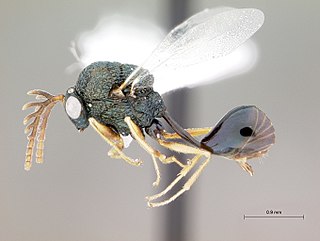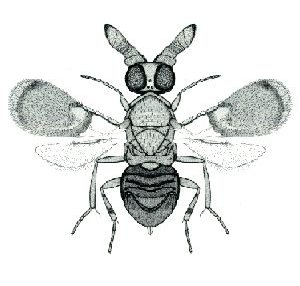
In evolutionary ecology, a parasitoid is an organism that lives in close association with its host at the host's expense, eventually resulting in the death of the host. Parasitoidism is one of six major evolutionary strategies within parasitism, distinguished by the fatal prognosis for the host, which makes the strategy close to predation.

The superfamily Ichneumonoidea contains one extinct and three extant families, including the two largest families within Hymenoptera: Ichneumonidae and Braconidae. The group is thought to contain as many as 100,000 species, many of which have not yet been described. Like other parasitoid wasps, they were long placed in the "Parasitica", variously considered as an infraorder or an unranked clade, now known to be paraphyletic.

The Braconidae are a family of parasitoid wasps. After the closely related Ichneumonidae, braconids make up the second-largest family in the order Hymenoptera, with about 17,000 recognized species and many thousands more undescribed. One analysis estimated a total between 30,000 and 50,000, and another provided a narrower estimate between 42,000 and 43,000 species.

Aprostocetus is a genus of hymenopteran insects of the family Eulophidae. The genus was erected by John O. Westwood in 1833. This very large group of parasitoid wasps has a global distribution.

The hymenopteran family Platygastridae is a large group of exclusively parasitoid wasps, mostly very small (1–2 mm), black, and shining, with geniculate (elbowed) antennae that have an eight-segmented flagellum. The wings sometimes lack venation, though they may have slight fringes of setae.

Parasitoid wasps are a large group of hymenopteran superfamilies, with all but the wood wasps (Orussoidea) being in the wasp-waisted Apocrita. As parasitoids, they lay their eggs on or in the bodies of other arthropods, sooner or later causing the death of these hosts. Different species specialise in hosts from different insect orders, most often Lepidoptera, though some select beetles, flies, or bugs; the spider wasps (Pompilidae) exclusively attack spiders.

The hymenopteran family Scelionidae is a very large cosmopolitan group of exclusively parasitoid wasps, mostly small (0.5–10 mm), often black, often highly sculptured, with (typically) elbowed antennae that have a 9- or 10-segmented flagellum. It was once considered to be a subfamily of the Platygastridae, but has been revived in the most recent classification of Platygastroidea.

The Eucharitidae are a family of parasitic wasps. Eucharitid wasps are members of the superfamily Chalcidoidea and consist of four subfamilies: Akapalinae, Eucharitinae, Gollumiellinae, and Oraseminae. Most of the 42 genera and >400 species of Eucharitidae are members of the subfamilies Oraseminae and Eucharitinae, and are found in tropical regions of the world.

Encyrtidae is a large family of parasitic wasps, with some 3710 described species in about 455 genera. The larvae of the majority are primary parasitoids on Hemiptera, though other hosts are attacked, and details of the life history can be variable. They are found throughout the world in virtually all habitats, and are extremely important as biological control agents. They may also present as an ecological threat to the population of some species. For example, the endangered Papilio homerus butterfly is parasitized at a rate of 77%, making them the main contributor to egg mortality in this butterfly species.

The Tetracampidae are a small family of parasitic wasps in the superfamily Chalcidoidea. They are parasitoids of phytophagous insects, primarily flies. The 44 species in 15 genera are almost entirely absent from the New World.

The Stephanidae, sometimes called crown wasps, are a family of parasitoid wasps. They are the only living members of the superfamily Stephanoidea. Stephanidae has at least 345 living species in 11 genera. The family is considered cosmopolitan in distribution, with the highest species concentrations in subtropical and moderate climate zones. Stephanidae also contain four extinct genera described from both compression fossils and inclusions in amber.

A wasp is any insect of the narrow-waisted suborder Apocrita of the order Hymenoptera which is neither a bee nor an ant; this excludes the broad-waisted sawflies (Symphyta), which look somewhat like wasps, but are in a separate suborder. The wasps do not constitute a clade, a complete natural group with a single ancestor, as bees and ants are deeply nested within the wasps, having evolved from wasp ancestors. Wasps that are members of the clade Aculeata can sting their prey.

Anastrepha ludens, the Mexican fruit fly or Mexfly, is a species of fly of the Anastrepha genus in the Tephritidae family. It is closely related to the Caribbean fruit fly Anastrepha suspensa, and the papaya fruit fly Anastrepha curvicauda.
Miracula is a genus of parasitic protists that parasite diatoms, containing the type species Miracula helgolandica. More recently, the species Miracula moenusica from the river Main in Frankfurt am Main, Miracula islandica from a shore in the north of Iceland, Miracula einbuarlaekurica from a streamlet in the north of Iceland, and Miracula blauvikensis from the shore at the research station Blávík in the east fjords of Iceland were added to the genus. It is the only genus in the family Miraculaceae, of uncertain taxonomic position within the Oomycetes. They're one of the most basal lineages in the phylogeny of Oomycetes.

Parvilucifera is a genus of marine alveolates that behave as endoparasites of dinoflagellates. It was described in 1999 by biologists Fredrik Norén and Øjvind Moestrup, who identified the genus among collections of Dinophysis dinoflagellates off the coast of Sweden. Initially mistaken for products of sexual reproduction, the round bodies found within these collections were eventually recognized as sporangia, spherical structures that generate zoospores of a parasitic protist. This organism was later identified as P. infectans, the type species. The examination of this organism and its close genetic relationship to Perkinsus led to the creation of the Perkinsozoa phylum within the Alveolata group.
Liopteridae is a family of wood-boring parasitoid wasps. They occur worldwide with concentrations in the African Tropics. These insects have a petiolate abdomen. There are 10 genera and more than 140 species known.
John Stuart Noyes is a Welsh entomologist.

Diachasmimorpha longicaudata is a solitary species of parasitoid wasp and an endoparasitoid of tephritid fruit fly larvae. D. longicaudata is native to many countries in Southeast Asia and subtropical regions and has also been introduced to many other countries as a biological control agent. It is now considered the most extensively used parasitoid for biocontrol of fruit flies in both the southern portion of the United States and Latin America. D. longicaudata is especially useful for agricultural purposes in the control of fruit flies as it is easily mass-reared and has the ability to infect a variety of hosts within the genus Bactrocera. A negative factor in its use as a biocontrol agent is that it is known to oviposit in grapefruit in the state of Florida. This has resulted in quarantines on grapefruit shipped internationally as well as domestically. Research is ongoing to determine whether D. longicaudata is actually a single species, or if it contains multiple species. It is likely multiple biological species separated by both reproductive isolation and morphological characteristics such as wing geometry.

Anastrepha fraterculus, known as the South American fruit fly, is a fruit fly species from the genus Anastrepha. A. fraterculus is a polyphagous, frugivorous fly that is a significant pest of commercial fruit production in South America.















